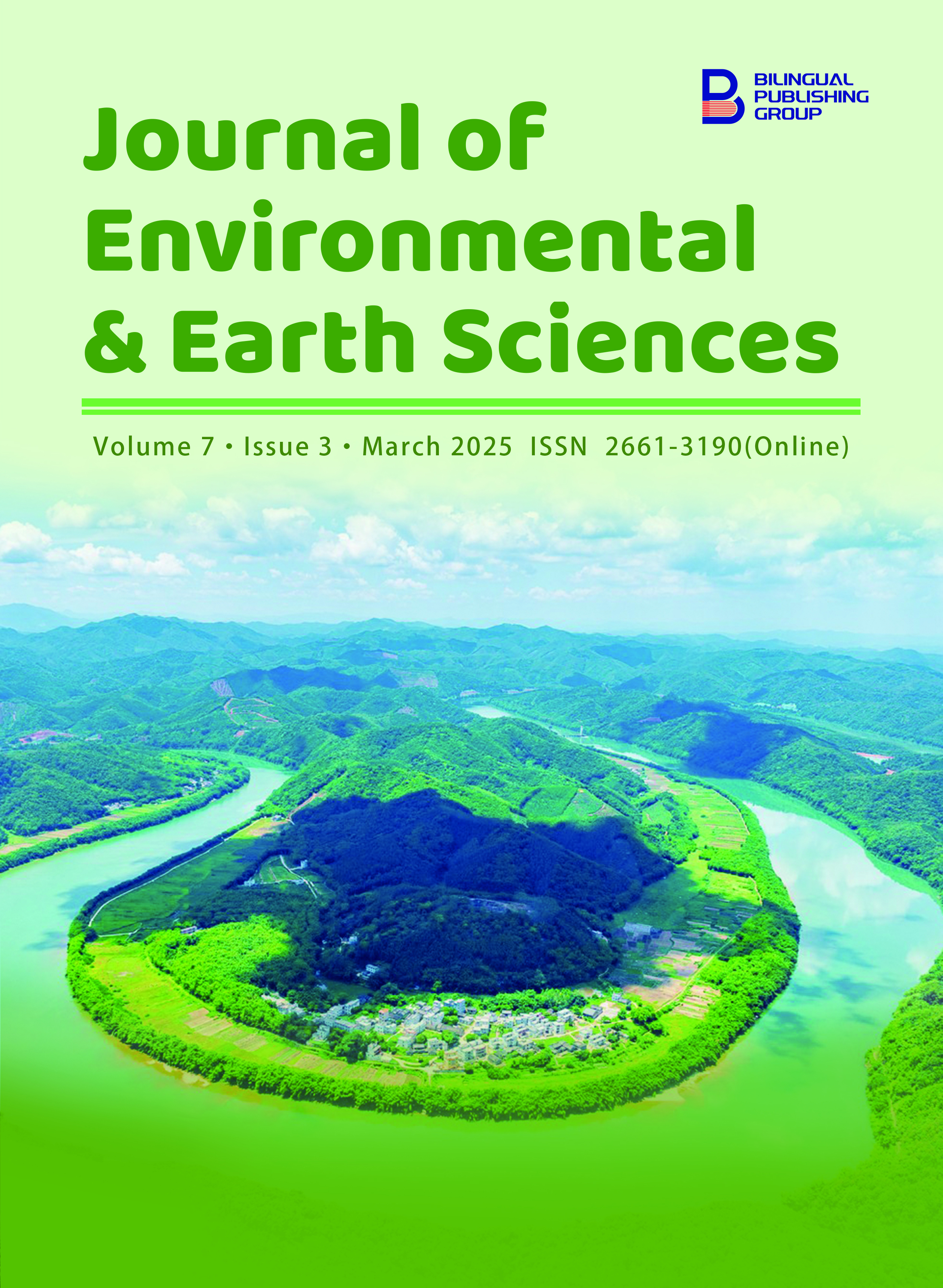
Assessing Megathrust Earthquake Probability, Public Stress, and Government Policy Recommendations in the Mentawai-Siberut Region, Indonesia
DOI:
https://doi.org/10.30564/jees.v7i3.8135Abstract
This study aims to assess seismic hazards and develop effective mitigation strategies for the Mentawai-Siberut region in Indonesia. The research uses quantitative and qualitative methods to analyze historical seismic data, predictive models, and stakeholder perspectives. The quantitative analysis includes seismic hazard estimation using the Gutenberg-Richter formula, ground movement analysis based on GMPE, and time interval calculations to forecast future earthquakes. Qualitative methods involve Policy Network Theory to explore the roles and interactions of various stakeholders in disaster management, including government agencies, theIndonesian Archipelago Youth Association (NGOs), local communities, and academic researchers. Findings reveal significant seismic activity in the area, with historical earthquakes of magnitudes 8 and 9 occurring at intervals of 18 to 232 years. Predictions suggest a potential magnitude 8 earthquake around 2083, with a megathrust event likely around 2123. The study also identifies economic costs and losses, with damage from a megathrust estimated between USD 1.5–2.5 billion and 10-20 billion, including destroyed homes and displaced populations. Challenges include infrastructure limitations, logistical constraints, and enhancing disaster preparedness and response. The study emphasizes the importance of improving infrastructure, strengthening disaster preparedness, and updating early warning systems. Effective collaboration among stakeholders and integrating local knowledge into disaster management strategies are crucial for enhancing regional resilience. Recommendations include completing infrastructure projects like the Trans-Mentawai Road, increasing community engagement, and utilizing scientific data for evidence-based policymaking. Addressing these recommendations and limitations is essential for developing a robust disaster management framework to mitigate regional seismic risks.
Keywords:
Megathrust Earthquakes; Infrastructure Damage; Earthquake Risk Assessment; Disaster Mitigation; Policy FormulationReferences
[1] Mukesh, R., Dass, S., Vijay, M., et al., 2024. Analysis of ionospheric TEC variations and prediction of TEC during earthquakes using ordinary Kriging based surrogate model. Geomagnetism Aeronomy. 63, S22–S43. DOI: https://doi.org/10.1134/S001679322360025X
[2] Prakoso, S., Wijaya, A., Putra, F. 2022. Indonesia’s disaster resilience against volcanic eruption: Lessons from Yogyakarta. KnE Social Science. 114–125. DOI: https://doi.org/10.18502/kss.v7i5.10544
[3] Hassin Alasadi, A.H., Hashim, K.M., 2023. Earthquake prediction technique: A comparative study. IAES International Journal of Artificial Intelligence. 12, 1026. DOI: https://doi.org/10.11591/ijai.v12.i3.pp1026-1032
[4] Supendi, P., Widiyantoro, S., Muhari, A., et al., 2020. Potential megathrust earthquakes and tsunamis off the southern coast of West Java, Indonesia. Preprint. DOI: https://doi.org/10.21203/rs.3.rs-104583/v1
[5] Fauziyah, N.N., 2024. BMKG Clarifies on Megathrust Earthquake Warning in Indonesia. Available from: Tempo.co online. Available from: https://en.tempo.co/read/1904138/bmkg-clarifies-on-megathrust-earthquake-warning-in-indonesia (cited 15 August 2024).
[6] Muhammad, A., Goda, K., Alexander, N., et al., 2017. Tsunami evacuation plans for future megathrust earthquakes in Padang, Indonesia considering stochastic earthquake scenarios. Natural Hazards and Earth System Sciences. 17, 1–26. DOI: https://doi.org/10.5194/nhess-17-2245-2017
[7] Huang, H., Wang, F., Xiao, Y., et al., 2022. To stay or to move? Investigation on residents’ migration intention under frequent secondary disasters in the Wenchuan earthquake-stricken area. Frontiers in Public Health. 10, 1–12. DOI: https://doi.org/10.3389/fpubh.2022.920233
[8] Amirsardari, A., Sofi, M., Lumantarna, E., et al., 2019. Impact of earthquakes on the transportation infrastructure of Indonesia: A preliminary study. Civil Engineering Dimension. 21, 19–28. DOI: https://doi.org/10.9744/ced.21.1.19-28
[9] Pranata, B., Ramdhan, M., Sulaiman, M.I., et al., 2023. Rudarsko-geološko-naftni zbornik 3, 119–132. DOI: https://doi.org/10.17794/rgn.2023.3.10
[10] Foyouzati, A., 2024. Probabilistic seismic hazard assessment studies on the central-east of Iran—Kerman region. Iranian Journal of Science and Technology - Transactions of Civil Engineering. 48, 3457–3465. DOI: https://doi.org/10.1007/s40996-024-01428-3
[11] Stirling, M., Gerstenberger, M., 2018. Applicability of the Gutenberg–Richter relation for major active faults in New Zealand. Bulletin of the Seismological Society of America. 108(2), 718–728. DOI: https://doi.org/10.1785/0120160257
[12] Korkolis, E., Niemeijer, A., Paulssen, H., et al., 2021. A laboratory perspective on the Gutenberg‐Richter and characteristic earthquake models. Journal of Geophysical Research: Solid Earth. 126, 1–21. DOI: https://doi.org/10.1029/2021JB021730
[13] Zobin, V., 2022. Volcano seismology: An introduction. In: Tilling, R.I. (ed.). Complexity in Tsunamis, Volcanoes, and their Hazards. Encyclopedia of Complexity and Systems Science Series. Springer: New York, NY, USA. pp. 393–424. DOI: https://doi.org/10.1007/978-1-0716-1705-2_607
[14] Zobin, V., Plascencia, I., 2022. Seismic risk in the State of Colima, México: Application of a simplified methodology of the seismic risk evaluation for the localities with low-rise, non-engineered housing. Geofísica Internacional. 61, 113–143. DOI: https://doi.org/10.22201/igeof.00167169p.2022.61.2.2199
[15] Osborne, N., Grant-Smith, D., 2021. In-Depth Interviewing. Springer: Singapore. pp. 105–125. ISBN: 978-981-16-1676-1. DOI: https://doi.org/10.1007/978-981-16-1677-8_7
[16] Samudra, A., Hertasning, B., Amiro, L., 2024. Policy for handling air pollution in Jakarta: Study using system dynamics simulation models. 8, 1–18. DOI: https://doi.org/10.24294/jipd.v8i2.2969
[17] Hermansyah, A., Samudra, A.A., Satispi, E., 2024. Policy dialogue: Key factors for the success of transit-oriented development infrastructure 3.0 in big cities in Indonesia. Journal of Infrastructure, Policy and Development. 8(5), 1–23. DOI: https://doi.org/10.24294/jipd.v8i5.3400
[18] Earthquake-News, 2024. Top 100 countries with most earthquakes. Available from: https://earthquakelist.org/reports/top-100-countries-most-earthquakes/ (cited 18 August 2024).
[19] BMKG, 2021. Indonesian earthquake catalog: Hypocenter relocation and implications tectonics, 1st ed. Meteorology, Climatology and Geophysics Agency: Jakarta, Indonesia. pp. 1–32.
[20] El-Hussain, I., et al., 2012. Probabilistic seismic hazard maps for the Sultanate of Oman. Natural Hazards. 64, 173–210. DOI: https://doi.org/10.1007/s11069-012-0232-3
[21] Fiedler, B., Hainzl, S., Zöller, G., et al., 2018. Detection of Gutenberg–Richter b‐value changes in earthquake time series. Bulletin of the Seismological Society of America. 108, 1–16. DOI: https://doi.org/10.1785/0120180091
[22] Ide, S., Yabe, S., Tanaka, Y., 2016. Earthquake potential revealed by tidal influence on earthquake size–frequency statistics. Nature Geoscience. 9 (11), 1–13. DOI: https://doi.org/10.1038/ngeo2796
[23] Chen, S., Chen, P., Wu, Y., et al., 2023. Temporal variations of earthquake magnitude‐frequency relation in the source area of M ≥ 6.0 earthquakes: A systematic survey in Taiwan. Earth and Space Science. 10, 1–16. DOI: https://doi.org/10.1029/2023EA002927
[24] Zhu, J., Li, S., Song, J., 2021. Magnitude estimation for earthquake early warning with multiple parameter inputs and a support vector machine. Seismological Research. Letters. 93(1), 1–11. DOI: https://doi.org/10.1785/0220210144
[25] Kijko, A., 2019. Seismic Hazard. In: Gupta, H.K. (ed.). Encyclopedia of Solid Earth Geophysics. Encyclopedia of Earth Sciences Series. Springer: Cham, Switzerland. pp. 1–14. DOI: https://doi.org/10.1007/978-3-030-10475-7_10-1
[26] Dally, D., Tuan Amith, M., Mauldin, R., et al., 2024. A semantic approach to describe social and economic characteristics that impact health outcomes (social determinants of health): Ontology development study. Online Journal of Public Health Informatics. e52845. DOI: https://doi.org/10.2196/52845
[27] Sayil, N., 2013. Long-term earthquake prediction in the Marmara region based on the regional time- and magnitude-predictable model. Acta Geophysica. 61, 338–356. DOI: https://doi.org/10.2478/s11600-012-0088-7
[28] Scharer, K., Streig, A., 2019. The San Andreas fault system: complexities along a major transform fault system and relation to earthquake hazards. In: Duarte, J.C. (ed.). Transform Plate Boundaries and Fracture Zones. Elsevier: California, USA. pp. 249–269. DOI: https://doi.org/10.1016/B978-0-12-812064-4.00010-4
[29] Ibrahim, M., Al-Bander, B., 2024. An integrated approach for understanding global earthquake patterns and enhancing seismic risk assessment. International Journal of Information Technology. 16, 1–14. DOI: https://doi.org/10.1007/s41870-024-01778-1
[30] Süleyman, H., Cakti, E., 2024. Assessing seismic hazard and uncertainty in Büyükçekmece using ground motion simulations, Bulletin of Earthquake Engineering. 22(10), 1–24. DOI: https://doi.org/10.1007/s10518-024-01953-6
[31] Asrurifak, M., Irsyam, M., Budiono, B., et al., 2010. Development of spectral hazard map for Indonesia with a return period of 2500 years using probabilistic Method. Civil Engineering Dimension. 12, 52–62. DOI: https://doi.org/10.9744/ced.12.1.52-62
[32] Djazilus, H., Asrurifak, M., Meilano, I., et al., 2018. Recent efforts to mitigate the impacts of earthquake hazard in Indonesia from geotechnical engineering perspective. In: Iai, S. (ed.). Developments in Earthquake Geotechnics. Springer: Midtown Manhattan, NY, USA. pp. 131–150. DOI: https://doi.org/10.1007/978-3-319-62069-5_7
[33] Harith, N., Tongkul, F., Adnan, A., 2023. Seismic hazard curve as dynamic parameters in earthquake building design for Sabah, Malaysia. Buildings. 13, 318. DOI: https://doi.org/10.3390/buildings13020318
[34] Bellalem, F., Molina, S., Daniell, J., et al., 2024. Seismic risk assessment for the downtown of the city of Blida, Algeria. International Journal of Disaster Risk Reduction. 103, 104314. DOI: https://doi.org/10.1016/j.ijdrr.2024.104314
[35] Seyedi Rezvani, S.M.H., Silva, M., Almeida, N., 2024. Urban resilience index for critical infrastructure: A scenario-based approach to disaster risk reduction in road networks. Sustainability. 16, 4143. DOI: https://doi.org/10.3390/su16104143
[36] Perera, D., Seidou, O., Agnihotri, J., et al., 2019. Flood early warning systems: a review of benefits, challenges and prospects. UNU-INWEH Report No. 08, 16 August, 2019. DOI: https://doi.org/10.13140/RG.2.2.28339.78880
[37] Samudra, A.A., 2024. Disaster in the Ring of Fire and Black Swan Earthquake Theory (Techniques for disaster management with modern technology and local wisdom), 1st ed. Samudra Biru Yogyakarta: Jakarta, Indonesia. pp. 1–430. ISBN: 978-623-261-726-1.
[38] Ramadhan, A., Taqiyuddin, 2024. Disaster mitigation with local wisdom in the community of West Sumatra. Journal of Geographical Sciences and Education. 2, 67–72. DOI: https://doi.org/10.69606/geography.v2i2.90
[39] Rampal, T., Goel, M., Chawra, B., et al., 2023. Potential use of bamboo as a sustainable material in construction in India: A survey of literature. Journal of the International Society for the Study of Vernacular Settlements. 10, 90–103. DOI: https://doi.org/10.61275/ISVSej-2023-10-09-07
[40] Fajrin, J., Sugiartha, I.W., Eniarti, M., 2021. Bamboo-based temporary house for post disaster relief: A conceptual design and prototype built after Lombok Earthquake 2018. IOP Conference Series: Earth and Environmental Science. 708, 012076. DOI: https://doi.org/10.1088/1755-1315/708/1/012076
[41] Husna, C., Hafni, M., Yahya, M., et al., 2020. Utilizing educational media of disaster mitigation on earthquake and tsunami preparedness for inpatient families in hospital. In: Tahlil, T., Kamil, H., Asniar, M. (eds.). Challenges in Nursing Education and Research, 1st ed. CRC Press: Boca Raton, FL, USA. pp. 193–205. DOI: https://doi.org/10.1201/9781003043973-21
[42] VOI, 2024. People are worried about the megathrust earthquake, the DPR encourages the government to immediately mitigate. Available from: https://voi.id/en/news/409878 (cited 11 October 2024).
[43] Marcon, G., Alberton, A., Florez, D., 2022. Stakeholder theory and actor‐network theory: The stakeholder engagement in energy transitions. Business Strategy and the Environment. 32, 1–14. DOI: https://doi.org/10.1002/bse.3168
[44] Balane, M., Palafox, B., Palileo-Villanueva, L.A., et al., 2020. Enhancing the use of stakeholder analysis for policy implementation research: Towards a novel framing and operationalised measures. BMJ Glob. Health. 5(1), 1–12, DOI: https://doi.org/10.1136/bmjgh-2020-002661
[45] Wang, H., Ran, B., 2021. Network governance and collaborative governance: A thematic analysis on their similarities, differences, and entanglements. Public Management Review. 25(5), 1–27. DOI: https://doi.org/10.1080/14719037.2021.2011389
[46] Ardiansyah, M., Mirandah, E., Suyatno, A., et al., 2024. Disaster management and emergency response: Improving coordination and preparedness. Global International Journal of Innovative Research. 2, 831–839. DOI: https://doi.org/10.59613/global.v2i4.129
[47] Seyedi Rezvani, S.M.H., Silva, M., Almeida, N., 2024. The Risk-Informed Asset-Centric (RIACT) urban resilience enhancement process: An outline and pilot-case demonstrator for earthquake risk mitigation in Portuguese municipalities. Applied Sciences. 14(2), 634. DOI: https://doi.org/10.3390/app14020634
[48] Eze, E., Petersen, M., Siegmund, A., 2024. Enhancing protection motivation for disaster preparedness among actors at UNESCO-designated heritage sites in Africa. International Journal of Disaster Risk Reduction. 109(2), 1–16. DOI: https://doi.org/10.1016/j.ijdrr.2024.104599
Downloads
How to Cite
Issue
Article Type
License
Copyright © 2025 Zainal Muksin, Abdur Rahim, Suradika, Ma’mun Murod, Andriansyah, Evi Satisipi, Azhari Aziz Samudra

This is an open access article under the Creative Commons Attribution-NonCommercial 4.0 International (CC BY-NC 4.0) License.







 Zainal Muksin
Zainal Muksin






